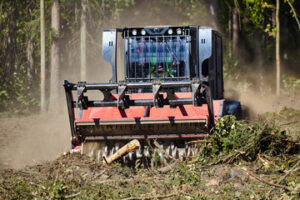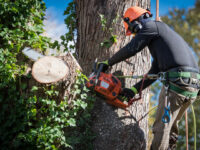Why Forestry Mulching Is the Best Choice for Clearing Overgrown Land
Forestry Mulching Manor TX is the best choice for clearing overgrown land due to its efficiency and environmental benefits. Overgrown land can present various challenges, from obstructing views to limiting the use of the property for agricultural, recreational, or developmental purposes.
Traditional methods of clearing land, such as bulldozing, burning, and manual removal, can be labor-intensive, expensive, and damaging to the environment. Forestry mulching offers a more effective solution by combining cutting, grinding, and clearing in one streamlined process.
This method not only removes unwanted vegetation but also enhances soil quality and promotes healthier land conditions. The mulch produced during the process acts as a natural ground cover, preventing erosion and improving moisture retention, which supports the growth of native plants and enhances the overall health of the land.
One of the primary reasons forestry mulching stands out as the best method for land clearing is its ability to handle a wide range of vegetation types and terrain conditions. The specialized equipment used in forestry mulching is designed to cut and grind various types of plant material, including trees, shrubs, and underbrush, regardless of the density or size of the growth. This versatility makes forestry mulching ideal for clearing both small residential lots and large commercial or agricultural properties. Unlike bulldozing, which can disturb the soil and create uneven surfaces, forestry mulching preserves the integrity of the land by leaving a layer of organic mulch behind. This mulch decomposes over time, enriching the soil with nutrients and promoting the growth of healthier vegetation.
Another advantage of forestry mulching is its efficiency and cost-effectiveness. Traditional land-clearing methods often require multiple steps, including cutting, hauling, and disposing of debris, which increases labor and equipment costs. Forestry mulching combines all these steps into a single operation, reducing the time and expense involved in the clearing process. The mulch created during the process eliminates the need for debris removal and disposal, further reducing costs and minimizing environmental impact. Additionally, the protective layer of mulch left on the ground helps to prevent soil erosion and retains moisture, which reduces the need for irrigation and other maintenance measures. This makes forestry mulching a more sustainable and economically viable solution for land management.
Forestry mulching also plays a key role in improving soil health and promoting better land use. The mulch produced during the process acts as a natural soil conditioner, adding organic matter and nutrients to the soil as it decomposes. This enhances the soil’s structure, improves water retention, and supports the growth of native plant species. The mulch layer also helps to regulate soil temperature, reducing the impact of extreme weather conditions on plant growth. By improving soil health, forestry mulching creates a more resilient and productive landscape that can better support agricultural activities, landscaping projects, and natural vegetation growth.
The environmental benefits of forestry mulching extend beyond soil health and vegetation growth. Unlike burning or chemical treatments, which can release harmful emissions and pollutants into the air and water, forestry mulching is an environmentally friendly method that minimizes ecological disturbance. The mulch left behind provides a protective barrier that reduces runoff and prevents sediment from entering nearby water sources, protecting aquatic ecosystems and maintaining water quality. Forestry mulching also supports biodiversity by creating a more balanced and natural environment where native plant species can thrive. This helps to restore ecological balance and provides habitat for wildlife, contributing to a healthier and more diverse ecosystem.
Forestry mulching is particularly effective in controlling invasive plant species and managing overgrown vegetation. Invasive plants often spread quickly and outcompete native species for resources, disrupting the natural balance of the ecosystem. Forestry mulching removes invasive plants at the root level, preventing them from regrowing and spreading. The mulch left behind creates favorable conditions for native plants to recover and thrive, reducing competition and supporting a healthier plant community. This targeted approach to vegetation management helps to restore the natural diversity and resilience of the landscape, making it more resistant to future infestations.
Fire prevention is another significant benefit of forestry mulching. Overgrown vegetation and dry underbrush create ideal conditions for wildfires, increasing the risk of fire outbreaks and making them more difficult to control. Forestry mulching reduces this risk by clearing away excess vegetation and creating firebreaks that limit the spread of flames. The layer of mulch left on the ground helps to retain moisture and reduce the flammability of the cleared area, further decreasing the likelihood of fire. By reducing fuel sources and creating natural barriers, forestry mulching helps to protect property, infrastructure, and natural habitats from the devastating effects of wildfires.
The aesthetic improvements resulting from forestry mulching also contribute to its value as a land-clearing method. Overgrown land can make a property look neglected and uninviting, diminishing its curb appeal and overall value. Forestry mulching creates a clean and well-maintained appearance by removing excess vegetation and leaving behind a uniform layer of mulch. This enhances the visual appeal of the property and makes it more attractive for potential buyers, tenants, or visitors. Improved sightlines and open spaces also create a more functional and enjoyable outdoor environment, increasing the overall usability and value of the property.
Forestry mulching offers greater flexibility and accessibility compared to other land-clearing methods. The specialized equipment used in forestry mulching is designed to operate on various types of terrain, including steep slopes, rocky ground, and uneven surfaces. This allows for effective clearing of areas that may be difficult to access using traditional methods. The ability to maneuver through tight spaces and around existing structures makes forestry mulching suitable for a wide range of projects, from residential and commercial properties to agricultural fields and natural conservation areas. The adaptability of forestry mulching ensures that it can be tailored to meet the specific needs and challenges of each project, providing a customized and efficient solution for land clearing and management.
Forestry mulching also minimizes the disruption and damage caused to the land during the clearing process. Traditional methods such as bulldozing and excavating can compact the soil, disrupt natural drainage patterns, and destroy native plant species. Forestry mulching preserves the natural contour of the land and minimizes soil disturbance by leaving the root systems of desirable plants intact. The mulch layer helps to protect the soil from compaction and erosion, allowing for faster recovery and regrowth of vegetation. This low-impact approach to land clearing ensures that the land remains healthy and productive while reducing the need for costly restoration efforts.
Another key advantage of forestry mulching is its ability to enhance the long-term health and productivity of the land. The organic material from the mulch improves soil fertility and promotes the growth of native vegetation, creating a more balanced and sustainable ecosystem. The improved soil structure and moisture retention also support healthier root development and stronger plant growth, reducing the need for artificial fertilizers and irrigation. Forestry mulching creates a self-sustaining environment where natural vegetation can thrive, reducing maintenance requirements and improving the overall resilience of the land.
Forestry mulching is also a practical solution for improving access and usability of the land. Overgrown vegetation can create obstacles and hazards, making it difficult to navigate and utilize the property for recreational or agricultural purposes. Forestry mulching creates clear and open spaces that are easier to access and maintain. This enhances the overall functionality of the property and allows for greater flexibility in land use. The improved visibility and accessibility also increase safety by reducing the risk of hidden obstacles and potential hazards. Forestry mulching can be used to create and maintain trails, paths, and access roads, further enhancing the usability and value of the property.
In conclusion, forestry mulching is the best choice for clearing overgrown land due to its efficiency, cost-effectiveness, and environmental benefits. Its ability to clear vegetation, improve soil health, prevent erosion, and support native plant growth makes it an ideal solution for a wide range of land management projects. The protective layer of mulch left behind enriches the soil, reduces maintenance needs, and enhances the overall resilience of the land. Forestry mulching also improves the visual appeal and usability of the property, increasing its value and attractiveness. By choosing forestry mulching, property owners can create healthier, more functional, and more sustainable landscapes while minimizing environmental impact and long-term maintenance costs.






